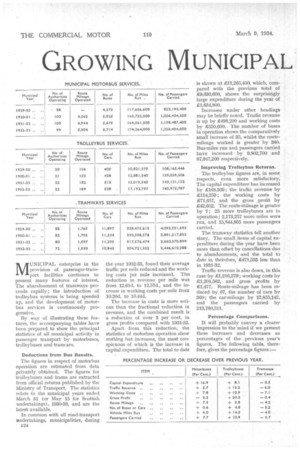GROWING MUNICIPAL BUS-SERVICE ENTERPRISE
Page 90

Page 91

If you've noticed an error in this article please click here to report it so we can fix it.
MUNICIPAL enterprise in the provision of passenger-transport facilities continues to present many features of interest. The abandonment of tramways proceeds rapidly ; the introduction of trolleybus systems is being speeded up, and the development of motorbus services is continuously progressive.
By way of illustrating these features, the accompanying tables have been prepared to show the principal statistics of all municipal activity in passenger transport by motorbuses, trolleybuses and tramcars.
Deductions from Bus Results.
The figures in respect of motorbus operation are estimated from data privately obtained. The figures for trolleybuses and trams are extracted from official returns published by the Ministry of Transport. The statistics relate to the municipal years ended March 31 (or May 15 for Scottish undertakings), 1930-33, and are the latest available.
In common with all road-transport undertakings, municipalities, during E24 the year 1932-33, found their average traffic per mile reduced and the working costs per mile increased. The reduction in revenue per mile was, from 12.61d. to 12.57d., and the increase in working costs per mile from 10.26d. to 1044d.
The increase in costs is more serious than the fractional reduction in revenue, and the combined result is a reduction of over 3 per cent, in. gross profits compared with 1931-32.
Apart from this reduction, the statistics of motorbus operation show nothing but increases, the most conspicuous of which is the increase in capital expenditure. The total to date is shown at 211,265,400, which, compared with the previous total of 29,630,600, shows the surprisingly large expenditure during the year of 21,634,800.
Increases under other headings may be briefly noted. Traffic revenue is up by 2498.200 and working costs by 2550,600. The number of buses in operation shows the comparatively small increase of 35, whilst the routemileage worked is greater by 360. Bus-miles run and passengers carried have increased by 9,802,700 and 87,947,200 respectively.
Improving Trolleybus Returns.
The trolleybus figures are, in some respects, even more satisfactory. The capital expenditure has increased by £163,369; the traffic revenue by £114,259; the working costs by 271,657, and the gross ,profit by 242,602. The route-mileage is greater by 7; 25 more trolleybuses are in operation ; 2,173,257 more miles were run, and 15,844,865 more passengers carried.
The tramway statistics tell another story. The smallitems of capital expenditure during the year have been more than offset by cancellations due to abandonments, and the total to date is, theirefore, 2471,533 less than in 1931-32.
Traffic revenue is also down, in this case•by £1,216,279; working costs by 21,201,562, and gross profits by 21,477. Route-mileage has been reduced by 67, the number of cars by 360; the car-mileage by 12,855,142, and the passengers carried by 213,760,511.
Percentage Comparisons. It will probably convey a clearer impression to the mind if we present these increases and decreases as percentages of the previous year's figures. The following table, therefore, gives the percentage figures :— It is interesting to notice here the proportionately greater increase in traffic secured by trolleybuses during the year under review.
In passing, it may also be of interest to note the proportion of public-service-vehicle traffic worked by municipal authorities (including joint committees of local authorities and railway companies) as a percentage of the total volume of such traffic throughout the country. They are as follow :—Buses owned, 12.15; seating capacity, 15.46; passengers carried, 22.46; bus-miles run, 13.13; passenger receipts, 15.48.
Fewer Tramway Operators.
Concluding our comments on the tables, it will be seen that the number of tramway-operating authorities has decreased by eight and the number of bus-operating authorities by one. Actually, the number of bus-operating authorities has now been reduced to 97, owing to the Burnley, Collie and Nelson merger.
In the case of the tramway-operating authorities, the eight systems referred to have been abandoned ; but readers of The Commercial Motor will not need to be reminded that in the case of the bus-operating authorities, the reduction in numbers does not imply that fewer municipalities are enjoying the facilities of the motorbus.
The explanation lies, of course, in the fact that some municipalities have entered into "co-ordination agreements" with companies and share in the administration and the profits of the services, whilst no longer directly operating them. Others have sold their interests outright to company operators.
Merger Schemes to the Fore.
These lines of action have been fairly prominent in the municipal field during the past year or so, and one or two similar arrangements are still under discussion. We now appear to he on the threshold of a new phase—or should we not say an old phase elaborated?
We refer, of course, to the municipal merger scheme proposed in the Lancashire-Cheshire area, embracing the undertakings of Manchester, Ashton-under-Lyne, Bolton, Bury, Oldham, Rochdale, Salford and Stockport Corporations, and the undertaking of the Stalybridge,
Hyde, Mossley and Dukinfield Joint Board.
This is a proposal involving capital assets valued at some £10,000,000, and concerning the progress of which our readers have from time to time been informed.
Overcoming a Handicap.
The handicap on municipal bus operation in the past has been, as everyone has recognized, its confinement, generally speaking, within comparatively small areas.
The general managers of the undertakings mentioned are satisfied that there should be no such arbitrary boundaries for transport pur poses, and now that the Road Traffic Act has placed municipal authorities on the same licensing level as companies, the problem of finding a way out requires solution.
This scheme, if and when it matures, will provide one of the most important features of municipal enterprise in transport, and the consequences may be far-reaching. But the area concerned is an exceptional one; there is probably no other in the country where a municipal merger of such magnitude could be carried out.
A first-hand account of this impertant enterprise is contained elsewhere in this issue.












































































































































































